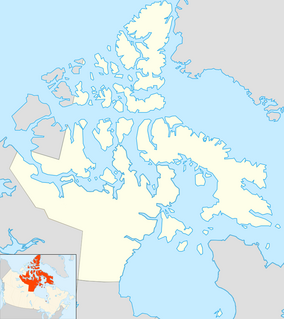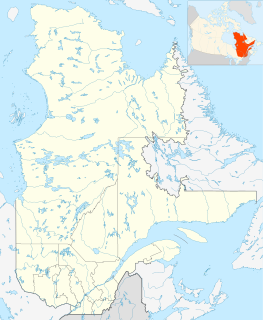In meteorology and aviation, terminal aerodrome forecast (TAF) is a format for reporting weather forecast information, particularly as it relates to aviation. TAFs are issued every six hours for major civil airfields: 0000, 0600, 1200 and 1800 UTC, and generally apply to a 24- or 30-hour period, and an area within approximately five statute miles (8.0 km) from the center of an airport runway complex. TAFS are issued every three hours for military airfields and some civil airfields and cover a period ranging from 3 hours to 30 hours.

Eureka Aerodrome is located at Eureka, Nunavut, Canada, and is operated by Environment Canada.
The National Information Exchange Model (NIEM) is an XML-based information exchange framework from the United States. NIEM represents a collaborative partnership of agencies and organizations across all levels of government and with private industry. The purpose of this partnership is to effectively and efficiently share critical information at key decision points throughout the whole of the justice, public safety, emergency and disaster management, intelligence, and homeland security enterprise. NIEM is designed to develop, disseminate, and support enterprise-wide information exchange standards and processes that will enable jurisdictions to automate information sharing.

Fort Simpson Airport is located 7.4 nautical miles east southeast of Fort Simpson, Northwest Territories, Canada.

Makkovik Airport is 0.5 nautical miles west of Makkovik, Newfoundland and Labrador, Canada.

Kangirsuk Airport is located 0.5 nautical miles east of Kangirsuk, Quebec, Canada.

Kangiqsujuaq Airport,, is located 0.7 nautical miles southeast of Kangiqsujuaq, Quebec, Canada.
In aviation meteorology, a trend type forecast (TTF), also known simply as a trend, is a weather forecast written by a person on location at a major airport or military base. A TTF is a professionally considered forecast for weather over a two-hour period, and is based on an actual weather report, such as a METAR or SPECI and appended to the end of it. A TTF is similar to or sometimes in addition to a TAF, a terminal aerodrome forecast, but during the TTF's validity period is considered superior to a TAF.

Sandy Lake Airport,, is located adjacent to Sandy Lake, Ontario, Canada.

Stony Rapids Airport is located adjacent to Stony Rapids, Saskatchewan, Canada.
An AIRMET, or Airmen's Meteorological Information, is a concise description of weather phenomena that are occurring or may occur (forecast) along an air route that may affect aircraft safety. Compared to SIGMETs, AIRMETs cover less severe weather: moderate turbulence and icing, sustained surface winds of 30 knots or more, or widespread restricted visibility.
In aviation, an Aeronautical Information Publication is defined by the International Civil Aviation Organization as a publication issued by or with the authority of a state and containing aeronautical information of a lasting character essential to air navigation. It is designed to be a manual containing thorough details of regulations, procedures and other information pertinent to flying aircraft in the particular country to which it relates. It is usually issued by or on behalf of the respective civil aviation administration.
CityGML is an open standardised data model and exchange format to store digital 3D models of cities and landscapes. It defines ways to describe most of the common 3D features and objects found in cities and the relationships between them. It also defines different standard levels of detail (LoDs) for the 3D objects, which allows the representation of objects for different applications and purposes, such as simulations, urban data mining, facility management, and thematic inquiries.
The Aeronautical Information Exchange Model (AIXM) is designed to enable the management and distribution of Aeronautical Information Services (AIS) data in digital format. AIXM is based on Geography Markup Language (GML) and is one of the GML Application Schemas which is applicable for the Aeronautical domain. It was developed by the US Federal Aviation Administration (FAA), the US National Geospatial Intelligence Agency (NGIA) and the European Organisation for the Safety of Air Navigation (EUROCONTROL).The current version is AIXM 5.1.1.

Surface weather observations are the fundamental data used for safety as well as climatological reasons to forecast weather and issue warnings worldwide. They can be taken manually, by a weather observer, by computer through the use of automated weather stations, or in a hybrid scheme using weather observers to augment the otherwise automated weather station. The ICAO defines the International Standard Atmosphere (ISA), which is the model of the standard variation of pressure, temperature, density, and viscosity with altitude in the Earth's atmosphere, and is used to reduce a station pressure to sea level pressure. Airport observations can be transmitted worldwide through the use of the METAR observing code. Personal weather stations taking automated observations can transmit their data to the United States mesonet through the Citizen Weather Observer Program (CWOP), the UK Met Office through their Weather Observations Website (WOW), or internationally through the Weather Underground Internet site. A thirty-year average of a location's weather observations is traditionally used to determine the station's climate. In the US a network of Cooperative Observers make a daily record of summary weather and sometimes water level information.
The Weather Information Exchange Model (WXXM) is a platform that was originally designed by EUROCONTROL for the exchange of weather related information between users.










